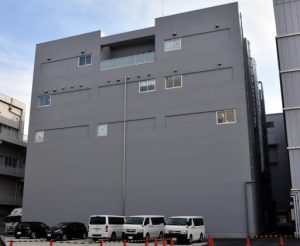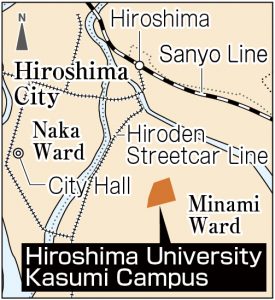RIRBM’s new laboratory, equipped with functions for low-dose research and nuclear-accident training, to open in April
Mar. 17, 2021
by Kyosuke Mizukawa, Staff Writer
Construction on a new research building that the Research Institute for Radiation Biology and Medicine (RIRBM) had been building on the Kasumi Campus of Hiroshima University in the city’s Minami Ward is now finished. Operations are set to begin in April. The new laboratory is to be equipped with some of the most advanced irradiation equipment in Japan, helpful for research into the as yet little-understood health effects of low-dose radiation exposure. The new lab also has a facility for training into the handling of nuclear disasters. The facility is expected to enhance RIRBM’s role as a hub research center promoting collaborative research with scientists at other institutions in Japan and overseas.
Construction of the five-story ferroconcrete building, with a total floor space of about 4,000 square meters, began in February 2020 on a site adjacent to RIRBM’s research center. The lab was completed at the end of January this year at a total cost of 1.76 billion yen.
The first floor is to serve as a center of training for the provision of emergency medical care in the event of nuclear disaster. Medical workers in and outside the university are expected to undergo training to measure internal exposure doses and clean up contaminated areas.
The space comprising the second to fourth floors will be dedicated to cell- and gene-level experiments using mice and other animals in which a wide variety of different radiation dose levels, from high to extremely low, can be utilized.
The RIRBM’s Radiation Information Registry Division, which is tasked with preserving A-bomb survivor medical records and related materials, will be moving to the fifth floor from another building on campus. The lab building will also house lecture halls and meeting rooms on the same floor for the holding of seminars and other gatherings.
The RIRBM was established in 1961 to provide medical care to A-bomb survivors and illuminate radiation damage. In 2016, the institute was recognized by the Ministry of Education, Culture, Sports, Science and Technology as a Radiation Disaster and Medical Science Research Center, along with Nagasaki University’s Atomic Bomb Disease Institute (Nagasaki City), and Fukushima Medical University’s Fukushima Global Medical Science Center (Fukushima City). With that, RIRBM has been sharing its facilities and conducting joint research with scientists from other organizations.
The old experiment facilities used to this point in time are in a location separate from the research building, but the space had become cramped and dilapidated. Satoshi Tashiro, RIRBM director, said, “Our new laboratory will be fully equipped with the latest radiation research equipment. The facilities will be the most advanced among any other university in Japan. Including the materials related to the victims of the atomic bombings, there is no research center quite like RIRBM in the world. I hope many people in Japan and overseas who are involved in radiation-related medical care and research will utilize the facilities.”
(Originally published on March 17, 2021)
Construction on a new research building that the Research Institute for Radiation Biology and Medicine (RIRBM) had been building on the Kasumi Campus of Hiroshima University in the city’s Minami Ward is now finished. Operations are set to begin in April. The new laboratory is to be equipped with some of the most advanced irradiation equipment in Japan, helpful for research into the as yet little-understood health effects of low-dose radiation exposure. The new lab also has a facility for training into the handling of nuclear disasters. The facility is expected to enhance RIRBM’s role as a hub research center promoting collaborative research with scientists at other institutions in Japan and overseas.
Construction of the five-story ferroconcrete building, with a total floor space of about 4,000 square meters, began in February 2020 on a site adjacent to RIRBM’s research center. The lab was completed at the end of January this year at a total cost of 1.76 billion yen.
The first floor is to serve as a center of training for the provision of emergency medical care in the event of nuclear disaster. Medical workers in and outside the university are expected to undergo training to measure internal exposure doses and clean up contaminated areas.
The space comprising the second to fourth floors will be dedicated to cell- and gene-level experiments using mice and other animals in which a wide variety of different radiation dose levels, from high to extremely low, can be utilized.
The RIRBM’s Radiation Information Registry Division, which is tasked with preserving A-bomb survivor medical records and related materials, will be moving to the fifth floor from another building on campus. The lab building will also house lecture halls and meeting rooms on the same floor for the holding of seminars and other gatherings.
The RIRBM was established in 1961 to provide medical care to A-bomb survivors and illuminate radiation damage. In 2016, the institute was recognized by the Ministry of Education, Culture, Sports, Science and Technology as a Radiation Disaster and Medical Science Research Center, along with Nagasaki University’s Atomic Bomb Disease Institute (Nagasaki City), and Fukushima Medical University’s Fukushima Global Medical Science Center (Fukushima City). With that, RIRBM has been sharing its facilities and conducting joint research with scientists from other organizations.
The old experiment facilities used to this point in time are in a location separate from the research building, but the space had become cramped and dilapidated. Satoshi Tashiro, RIRBM director, said, “Our new laboratory will be fully equipped with the latest radiation research equipment. The facilities will be the most advanced among any other university in Japan. Including the materials related to the victims of the atomic bombings, there is no research center quite like RIRBM in the world. I hope many people in Japan and overseas who are involved in radiation-related medical care and research will utilize the facilities.”
(Originally published on March 17, 2021)









